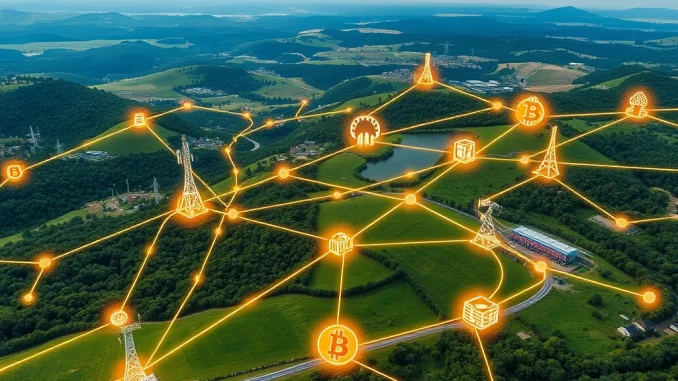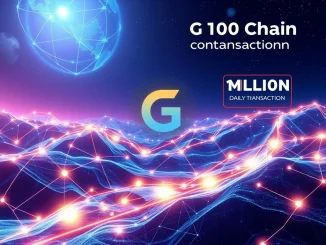
The crypto and technology worlds are buzzing following a significant **WEF prediction** that highlights a potentially massive opportunity. The **DePIN market**, short for Decentralized Physical Infrastructure Networks, is poised for extraordinary growth, according to a recent report from the World Economic Forum (WEF). This forecast suggests a leap from its current valuation of $30-$50 billion to a staggering $3.5 trillion by 2028. That’s a potential increase of over 100 times in just a few years, pointing towards a future increasingly built on **decentralized physical infrastructure**. This ambitious projection, reported by Cointelegraph, is largely attributed to the powerful convergence of blockchain and AI technologies.
What is Decentralized Physical Infrastructure (DePIN)?
Before diving deeper into the **WEF prediction**, let’s quickly break down what DePIN actually is. Think of it as using cryptocurrency incentives and blockchain technology to build, maintain, and operate real-world physical infrastructure networks. Instead of a single company owning and managing everything (like a traditional telecom provider or energy company), DePIN projects leverage a decentralized community of participants.
Here’s the core idea:
- Individuals or businesses contribute physical resources (like storage space, internet bandwidth, computing power, sensor data, energy).
- These contributions are verified and coordinated using blockchain technology.
- Contributors are rewarded with native cryptocurrency tokens for their service.
- Users of the network pay for the service using these tokens.
It’s a way to crowdsource infrastructure, making it potentially more resilient, cost-effective, and accessible than traditional centralized models.
The WEF Prediction: A Look at the Numbers
The World Economic Forum is a global organization known for bringing together leaders from various sectors to discuss major world issues. When they publish a report on a nascent technology sector like DePIN, it carries significant weight and signals growing mainstream recognition.
The report’s key takeaway is the projected market size jump:
- Current Value: Estimated at $30 billion to $50 billion.
- Predicted Value by 2028: Over $3.5 trillion.
This isn’t just incremental growth; it’s exponential. The WEF identifies this surge as being driven by the technological convergence we mentioned earlier – the combination of **Blockchain and AI** capabilities within these networks. The emergence of ‘Decentralized Physical AI’ (DePAI) is specifically highlighted as a key catalyst.
How Blockchain and AI Power DePIN Growth
The synergy between **Blockchain and AI** is fundamental to the optimistic **WEF prediction** for the **DePIN market**. Each technology brings essential elements to the table:
Blockchain’s Role:
- Decentralization & Trust: Provides a transparent, immutable ledger to track contributions and usage without a central authority.
- Tokenomics & Incentives: Enables the creation of native tokens to reward participants for providing resources and penalize malicious behavior. This aligns incentives within the network.
- Transparency: Network activity, payments, and resource availability can be publicly verifiable.
- Security: Cryptographic security protects data and transactions within the network.
AI’s Role:
- Optimization: AI algorithms can optimize resource allocation, routing, and pricing within the decentralized network.
- Data Processing: Handling and analyzing vast amounts of data generated by physical sensors and devices connected to the network.
- Automation: Automating tasks like maintenance scheduling, fraud detection, and quality control.
- Predictive Analysis: Forecasting demand, identifying potential issues before they occur, and improving network efficiency.
When combined in DePAI, AI can process data from physical sensors managed on a blockchain network, using that analysis to optimize the network’s performance and resource distribution, all while maintaining the decentralized, trustless nature provided by the blockchain layer. This powerful combination unlocks new levels of efficiency and functionality for **decentralized physical infrastructure**.
Exploring the DePIN Market Opportunity
The projected growth of the **DePIN market** isn’t just a number; it represents a significant opportunity across various sectors. The benefits of this model are compelling:
- Increased Efficiency and Reduced Costs: By removing intermediaries and optimizing operations with AI, DePIN can offer services more cheaply and efficiently.
- Greater Accessibility: Lowers the barrier for individuals and small businesses to become infrastructure providers, fostering competition and innovation.
- Enhanced Resilience: Decentralized networks are less prone to single points of failure or censorship compared to centralized systems.
- User Empowerment and Ownership: Participants often earn tokens, giving them a stake in the network they contribute to or use.
- Innovation in Resource Utilization: Enables new ways to monetize underutilized assets, like spare computing power or bandwidth.
This potential disruption spans industries including wireless connectivity (like Helium), decentralized storage (like Filecoin), compute power (like Render Network), energy grids (like Energy Web), sensor networks, and mobility data (like DIMO).
Challenges Facing Decentralized Physical Infrastructure
While the **WEF prediction** is exciting, it’s important to acknowledge that the path to a $3.5 trillion **DePIN market** isn’t without hurdles. Building and scaling **decentralized physical infrastructure** presents unique challenges:
- Scalability: Ensuring the underlying blockchain and AI systems can handle the immense scale of data and transactions generated by widespread physical networks.
- Regulatory Clarity: Navigating complex and often unclear regulations that vary significantly across jurisdictions regarding physical assets and decentralized networks.
- Adoption and User Experience: Making DePIN solutions user-friendly and reliable enough to compete with established centralized providers and gain mainstream adoption.
- Hardware Costs and Maintenance: The initial investment in physical hardware (sensors, nodes, devices) and ongoing maintenance can be significant for participants.
- Security of Physical Data: Ensuring the integrity and trustworthiness of data fed into the network from physical sensors is crucial.
Overcoming these challenges will require continued technological innovation, collaboration with regulators, and a focus on building robust, accessible, and truly decentralized networks.
Real-World DePIN Examples
Several projects are already building out **DePIN** networks, demonstrating the concept’s viability:

- Storage: Filecoin, Arweave, Sia provide decentralized cloud storage.
- Wireless: Helium builds decentralized wireless networks (IoT, Mobile).
- Compute: Render Network, Akash Network offer decentralized GPU rendering and cloud compute.
- Energy: Energy Web focuses on decentralized energy grids and applications.
- Sensors/Data: DIMO builds a decentralized network for vehicle data.
These examples showcase the diverse applications and the potential for DePIN to disrupt traditional infrastructure models.
Navigating the Future: Insights from the WEF prediction
The **WEF prediction** serves as a powerful indicator of the potential impact of **decentralized physical infrastructure**. For those interested in this space, whether as investors, developers, or users, here are some actionable insights:
- Research Projects: Dive deep into specific DePIN projects. Understand their technology, tokenomics, team, and market fit.
- Monitor Technological Advancements: Keep an eye on developments in both blockchain scalability and AI integration within these networks.
- Understand the Incentives: Evaluate how tokenomics truly incentivize reliable and widespread infrastructure provision.
- Consider Real-World Utility: Focus on projects solving tangible problems with clear use cases.
The convergence of **Blockchain and AI** within the DePIN framework is creating a new frontier for innovation and investment.
Conclusion
The World Economic Forum’s forecast of the **DePIN market** reaching over $3.5 trillion by 2028 is a bold statement that underscores the transformative potential of **decentralized physical infrastructure**. Fueled by the powerful combination of **Blockchain and AI**, DePIN is poised to revolutionize how we build, manage, and interact with the physical networks that underpin our world. While challenges remain, the vision of a more efficient, resilient, and accessible infrastructure built and owned by its users is a compelling one. This **WEF prediction** highlights DePIN as a sector ripe for explosive growth and significant disruption in the coming years.



